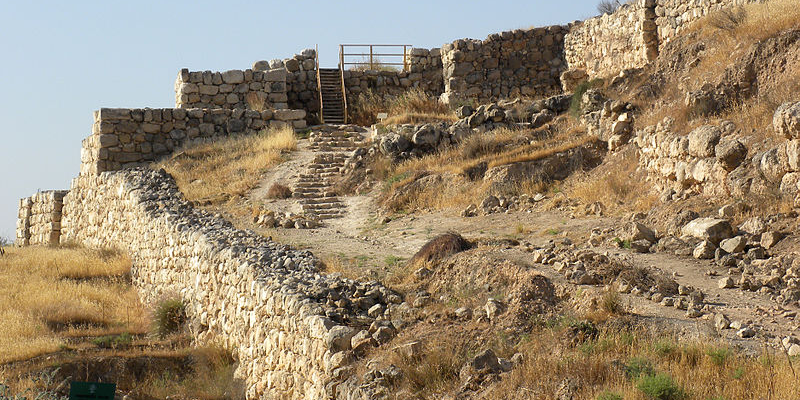‘And Joshua passed on from Libnah, and all Israel with him, to Lachish, and encamped against it, and fought against it. And G-d delivered Lachish into the hand of Israel…(Joshua 10: 31-32)’
By Nosson Shulman, Licensed Tour Guide
Today I will give you a tour of the unique biblical site called Lachish. This site, though not widely known, was actually Israel’s largest city during the biblical First Temple era (aside from Jerusalem). Unlike Jerusalem which hosts millions of tourists a year, Lachish almost always stands empty, even during the busiest tourist season. Allow me to explore this breathtaking gem with you now!
The city was one of the most powerful of the Canaanite cities with its own King. It controlled much of the surrounding territory.
Circa 1500 BCE, Israel was taken over by Egypt where they ruled for about 300 years (during the time the Children of Israel were enslaved). Egypt allowed the Canaanite Kings to keep their position as long as they stayed loyal to the Pharaoh. Lachish flourished during this time.
When the Children of Israel entered Israel, they waged war with 31 Canaanite city kings. After Jericho and Ai were conquered, the city of Gibeon decided it was better to make an alliance with Israel. Five kings, including Lachish, heard that the Gibeonites were seeking peace with Israel and were afraid that other City states would do the same. In order to prevent this, Lachish and the four other cities attacked Gibeon. Joshua then came to their aid, and G-d caused the five kings to immediately be confounded and flee. The Children of Israel then captured the Kings, along with their armies, and executed them (see Joshua 10). Soon after, Joshua entered Lachish itself and destroyed the city. Lachish was then given to the tribe of Judah (Joshua 15:39).
Israelite Lachish became an important city, partly due to its location on an important Ancient Highway (the road to Hebron or Jerusalem from Egypt went through here). Its fortifications were massive, and Lachish soon became the second biggest city in the Kingdom after Jerusalem.
Lachish became a regional capital city, which meant it had its own Governor. The Governor’s home was the largest palace ever found from Ancient Israel.
After Solomon’s death, his son Rehoboam became King. Under him, the Kingdom split into two, with Rehoboam retaining control of Judah, the southern kingdom. Fearing an invasion from the Northern Kingdom of Israel he fortified his cities, including Lachish which will still in his possession (2 Chronicles 11:9).
Circa 600 BCE, the Assyrian Kingdom of Northern Iraq became the world’s superpower. They had never lost a war or battle and were quite ruthless. They quickly conquered the Northern Kingdom of Israel. Under Assyrian King Sennacherib, King Hezekiah’s Kingdom of Judah was attacked, and Lachish was under siege (2 Chronicles 32:9).
During the siege, Assyrians built siege ramps to enter the city.
From Lachish, Sennacherib laid siege to Jerusalem with 185,000 troops. G-d created a miracle, and an angel came down and smote Sennacherib’s entire army. This destroyed Assyria’s threat to Judah, which continued to remain independent for close to 150 years.
The only one left alive was Sennacherib himself, and when he returned he documented his version of the story (which does not contradict the Biblical account). Throughout his palace, he bragged about conquering various capital cities. Only in Judah, did he boast about conquering a non-capital city, that of Lachish. As for Jerusalem, he said “He caged it like a bird” (basically saying that he failed to get the job done). Had he been able to conquer Jerusalem, it is almost guaranteed he would have bragged only about the capital city and not Lachish.
After the Assyrians left Judah, Lachish was rebuilt, once again remaining the second largest city in the Kingdom.
When the Babylonians conquered Judah, the last three cities holding out were Azekah, Lachish and Jerusalem (Jeremiah 34:7). Millenia later when archeologists dug inside the city gate, they found 20 letters between Hoshayahu, probably a commander of an outpost by Lachish to his superior Yaush during the Babylonian siege.
In one letter, Hoshayahu says “We’re watching for the signals of Lachish, according to all the indications… for we cannot see Azekah”. In other words, just as in Jeremiah, the letter mentions Lachish, Azekah and Jerusalem as being the last three cities left.
Ultimately, Lachish was destroyed, and its inhabitants exiled. With only a couple of exceptions, Lachish has laid in ruins since then.
Although tourists seldom come here, this site is beautiful with well preserved archeology, and the views alone warrant the visit! The quiet and pastoral setting of this site has a calming effect on tourists and on your next tour of Israel, this is a site I would most highly recommend.
Nosson Shulman is a licensed tour guide and trip organizer in Israel who specializes in History, Tanach (Bible) and Adventure Tours. For more itineraries click here. Check out his new virtual tours including free sneak preview videos.
